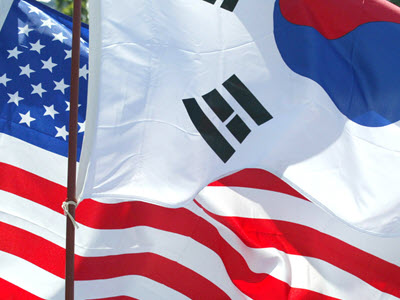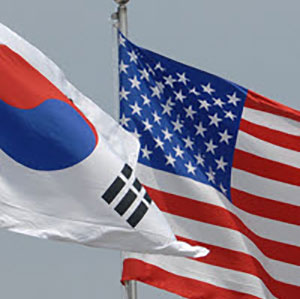U.S.-China Electric Vehicle Battery Competition and the Role of South Korea
Younkyoo Kim presents measures for the governments of South Korea and the United States to bolster U.S. and South Korean leadership in EV battery supply chains. This essay is part of the roundtable “U.S.-ROK Cooperation on Energy and Critical Minerals Supply Chains.”
Electric vehicle (EV) and battery production facilities concentrated in South Korea, China, and Japan are spreading to the United States and Europe in earnest. These trends coincide with a noticeable global rise in these products’ importance. In November 2021 the Conference of the Parties to the UN Framework Convention on Climate Change (COP26) adopted a declaration to stop selling internal combustion engine vehicles in Europe and North America by 2035 and the rest of the world by 2040. EVs are supposed to overtake internal combustion vehicles in market share in 2030.
South Korea, China, and Japan currently dominate the global battery market. Four battery cell manufacturers in China, three in South Korea, and three in Japan account for 90% of the world market. When it comes to battery technology and production capacity, the United States and European Union are far behind. Tesla in the United States and EV companies in Europe focus only on battery pack assembly, which is the final stage of the battery supply chain, while raw material mining, processing, and materialization for batteries and battery cell manufacturing occur mainly in South Korea, China, and Japan.
The United States and Europe are pursuing a strategy to expand cell manufacturing by prioritizing cooperation with battery makers in South Korea. Cell manufacturing can scale up relatively quickly, but the biggest obstacle to restructuring the supply chain is securing raw materials. Therefore, they are globalizing this competition—for example, by building battery-producing factories in Africa. This competition has been folded into the larger economic-technological rivalry between China and the United States.
The EV provisions in the U.S. government’s Inflation Reduction Act (IRA) went into effect in April and represent a legislative effort to achieve many domestic and foreign policy objectives. Chief among them is establishing U.S. primacy in the contest with China over batteries and EVs. The United States judges that China’s dominance of the battery supply chain and technology are challenges that have already become a serious threat to the U.S. economy and national security. A key purpose of the IRA is to accelerate the expansion of the U.S. EV industry and to shift the battery supply network that is dependent on China to the United States and its allies.
Since the Sino-U.S. rivalry is global in character, Washington is searching for allies and is prepared to subsidize states that might support U.S. efforts to counter China. Alexander Vuving observes, for example, that what drove U.S.-Vietnam rapprochement and convinced Vietnam to “leapfrog” to a full strategic partnership with the United States was the U.S. offer to turn the country into a major high-tech and semiconductor hub in a friend-shored supply chain by providing assistance for acquiring the necessary technology, market access, and capital.
South Korea’s EV and battery industry is another key economic component of Washington’s plan to expand the EV industry and establish a battery supply network in the United States. South Korea, however, is itself highly dependent on China for the manufacture of critical minerals and battery components.
The implementation of detailed IRA guidelines is an important milestone in assessing South Korea’s role in the Sino-U.S. competition for supremacy in EVs and batteries. The global battery industry is still in its infancy. The period from 2023 to 2025 is an important phase in de-Sinicizing the supply chain while accepting some degree of dependence on China for key minerals and parts. By 2030, around 40 battery factories will be newly built in the United States. By 2025, 13 priority facilities will already be built. Three South Korean battery companies are participating in 11 of these facilities. Whether South Korean companies can continue to take 70% of the new battery manufacturing capacity in the United States by 2030 will depend on how well they can adapt to the establishment of a non-Chinese supply chain that will be fully deployed after 2026, when the requirements for non-Chinese critical minerals and components in the supply chain will be stringently applied.
Thus, the IRA is already demonstrating the linkages between domestic economic-technological policy, ecological imperatives, and national security across continents and is a prime manifestation of the U.S.-China rivalry. Clearly this rivalry has already engendered critical moves by South Korean companies, given their dependence on Chinese supply chains. So this interlinking of domestic and foreign economic imperatives could be a harbinger of intensifying international rivalries in the fast-approaching future.
In the current environment, the governments of South Korea and the United States should strengthen cooperation through the following measures:
- Work to cultivate human talent in processing, smelting, and recycling critical minerals.
- Pursue joint mining technology development that is compliant with environmental, social, and governance standards.
- Implement joint projects to source critical minerals such as lithium, nickel, cobalt, rare earth elements, and graphite through U.S.-led multilateral platforms.
These actions will bolster U.S. and South Korean leadership in EV battery supply chains.
Younkyoo Kim is Dean of the School of International Studies and the Graduate School of International Studies and Director of the Institute for Energy and the Environment at Hanyang University in Seoul.



